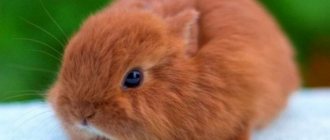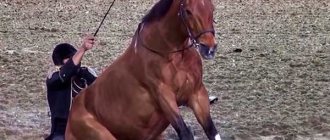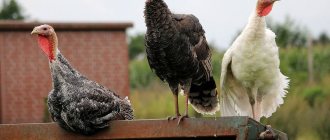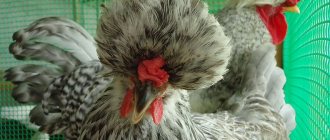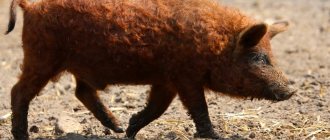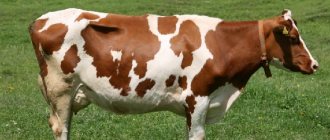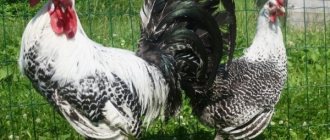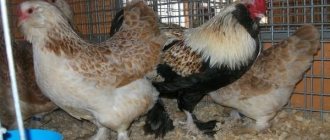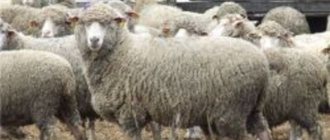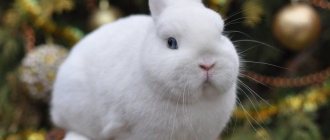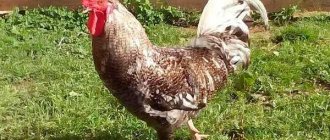Boer goats are a common breed. These meat animals are characterized by increased productivity. Boer goats are recognized by herders all over the world. Like other goat breeds, these animals require special care. It is necessary to pay attention to nutrition and breeding. The breed has some advantages and disadvantages regarding maintenance. You need to know this before you start raising this type of livestock.
Where was the Boer goat bred?
In countries that were formerly part of the Soviet Union, goat breeding is unpopular, but in other countries this area of animal husbandry is widespread and is also considered profitable.
Boer goats were bred at the beginning of the 20th century in southern Africa. The name is translated from the local dialect as “farmer”. African pastoralists have long been involved in goat breeding, and this area of livestock farming is popular in the country. This is explained by the fact that goats are able to adapt to any conditions.
Compared to other types of farm animals, such goats digest roughage better and are resistant to infectious and invasive pathologies. Thanks to the fact that African goat breeders have been breeding this group of livestock for centuries, it was possible to grow a livestock on South African territory, which served as the basis for breeding Boer goats.
Dutch settlers who arrived in South African lands decided to transform local livestock, for which systematic selection work was carried out. For this purpose, animals were brought from Europe and India, and over time, thanks to interbreeding, it was possible to obtain a high-quality hybrid. The work carried out made it possible to obtain several goat breeds, including Boer goats for meat production.
Thanks to its productive characteristics, the breed has become popular not only in the Republic of South Africa. New Zealand and American cattle breeders, who are considered the leaders of goat breeding, began to raise goats. In addition, cattle breeders from other countries are engaged in raising this type of farm animal.
Representatives of this breed are few in number in the Russian Federation. Breeding work with Boer goats is not carried out in Russia. Today there are some proposals and programs that will improve the local rough-haired cattle by crossing with Boer and other breeding goats for meat production.
Manufacturers
The advantages and disadvantages of Boer goats determine the possibilities of their breeding. Most often, interbreeding is carried out by crossing Boer goats with the queens of meat breeds. Purebred crossing is rarely practiced, as it is expensive. The price of the Boer goat breed reaches 100,000 rubles and more. For this amount you can purchase about ten heads of meat goats, which will be more profitable for the farmer.
When breeding, the goal is to gradually increase the proportion of Boer blood in the resulting animals. In this way, farmers manage to obtain a stable, highly productive cross. This model of goat breeding is used in many countries of the world where there is no developed dairy goat farming.
Breed overview
Boer goats have some characteristic qualities. A distinctive feature of this breed is its brown head, which stands out above the white body. In addition, this type of cattle is characterized by:
- large body mass: the average weight of a mature goat reaches 110 kg, although the body weight of individual individuals can be about 150 kg; but representatives of this female species weigh on average from 80 to 100 kg;
- short, smooth and silky coat;
- stocky and proportional build;
- powerful-looking limbs and the same body;
- hanging, large ears;
- short horns curved back, and they are almost invisible due to the fact that they are pressed to the body.
As for color, such goats have a body covered with white hair, and the neck and head of the animal are brown. Based on such characteristic features, Boer breed animals can be easily recognized.
In the countries of the former Soviet Union (Ukraine, Russia, Belarus, etc.), representatives of this type of cattle are not very popular. At the same time, in some Western European countries, southern Africa and America they are widespread.
In addition to the characteristic external signs, it should be noted that Boer goats differ from each other in character. For the most part, representatives of this breed are unpretentious animals, although there are also overly picky individuals.
Origin story
The breed was created in South Africa at the beginning of the 20th century. Dutch settlers, actively settling in new territories, decided to improve the quality of local goats by crossing with imported individuals. For this purpose, animals of European and Indian breeds were actively imported. As a result of hybridization, it was possible to breed high-quality livestock with stable characteristics:
- large size;
- characteristic external data;
- unpretentiousness in maintenance and resistance to diseases.
The name comes from the Dutch “boer” – a word meaning “peasant”, “farmer”. Another name for animals of this breed is boster.
Performance
The main purpose of keeping Boer goats is to obtain meat products.
The slaughter yield reaches approximately 54% of the live weight of the animal. Meat obtained from cattle of this variety is characterized by high taste. This is a tender and juicy product with an aroma reminiscent of the usual veal.
Female representatives are characterized by fertility and a highly developed maternal instinct. Over a two-year period, a female Boer breed is capable of bearing offspring up to three times.
Important! During the first litter, most often one kid is born. With each subsequent pregnancy, there can be two, and sometimes even three, cubs.
The duration of pregnancy in Boer goats is 5 months. The weight of a newborn goat reaches approximately 4 kg. Babies are characterized by active development and growth. The daily weight gain during the first months is approximately 250 grams. The duration of the suckling period is 3 months, after which the kids’ diet consists of the usual types of feed.
To avoid the appearance of an unpleasant specific aroma in the resulting meat products, young animals intended for slaughter are castrated at an early age. The skins of such cattle are also valuable.
Productivity
Boer goats are excellent mothers, this has a positive effect on the amount of growth in the herd, which is increasing rapidly. Young females give birth to 1 kid for the first time, and in subsequent births there are several kids. The uterus feeds them for 3 months. The owners can place the babies early if the goat is needed to obtain milk.
Since Boer goats are bred primarily for goat meat, the quality of the meat and its volume are especially valuable. The slaughter yield is 54 percent. The taste of goat meat is tender and juicy.
Boer goat nutrition
Separately, it is worth mentioning the nutrition of Boer goats. These representatives of cattle are unpretentious animals in terms of nutrition. However, experts advise following some rules when feeding:
- The diet should include greens in significant quantities. This breed is often used to get rid of problems with overgrown areas. To improve the garden area of a private house, Boer goats are an ideal option.
- During the warm period of the year, the basis of nutrition for this type of cattle should be fresh greens; if desired, supplementary feeding can be used. And in the cold season, hay should be used as the main food product for Boer goats.
- In addition, these animals should be fed vegetables, root vegetables and solid foods.
- Representatives of this breed are able to get used to any food; training must be carried out gradually and carefully. You should not suddenly switch livestock to new products, as this can lead to disruption of intestinal functions, as well as worsening the physical condition of the individual as a whole.
- Representatives of this breed for the most part have a calm and docile character, so they can easily get along in the same pasture with other farm animals, cows or horses.
Food for this type of livestock is a non-critical factor. They easily tolerate changes in diet and can eat both abundant and meager food. The diet must contain all the required vitamins and minerals for the body to develop and function normally.
If these simple requirements are met, the livestock breeder will be able to care for Boer goats without any problems. In the case of keeping representatives of this type of livestock for the purpose of obtaining offspring, further information on this issue should be studied.
How to keep Boer goats?
Keeping Boer goats requires following certain rules. For example, in a room for raising such livestock it is necessary to maintain a certain temperature, and also to properly plan the barn.
When breeding this breed of animals, the following recommendations must be followed:
- It is necessary to monitor the temperature in the barn where the goats live. The temperature should be maintained at a level of at least + 5 degrees, otherwise the animals may freeze, which is fraught with the development of diseases, worsening productivity, and weight loss.
- When keeping this breed of goat, it is mandatory to carry out periodic immunization, as well as undergo an examination by a veterinarian for preventive purposes.
- Boer goats need plenty of water: it is necessary to ensure that the animals have constant access to clean, fresh and high-quality drinking water so that they can quench their thirst at any time.
- Another important feature is the regulation of humidity levels in the barn. The humidity level should be no higher than 80%, on average this parameter should be between 60 and 70%. Excessive humidity is a favorable environment for the progression of all kinds of pathogenic microorganisms, which is why animals begin to develop health problems.
- The livestock breeder must provide livestock with warm bedding. The limbs of representatives of this breed are a weak point, for this reason goats can easily catch a cold during the cold season in the absence of insulation on the floor.
- Boer goats need hoof trimming twice every year. Since during the cold months animals do not have the opportunity to walk on regular ground, it is necessary to trim the hooves from the growths that have formed on them. The pruning procedure is carried out twice during the year: before the start of keeping in the barn, and also at the end of winter.
- It is necessary to control the length of daylight hours in the barn during the cold season. They must last for at least 8 hours. For this purpose, the premises for keeping livestock must be provided with artificial lighting. In addition, an automatic day-night change can be configured, or this procedure can be performed manually.
- While the weather is warm outside: in the summer, in the spring months and at the beginning of autumn, goats should be walked, for which you need to choose a place for pasture land. Animals need green vegetation. In the case where some valuable plants grow on the territory used as pasture, it is recommended to erect a fence around them, or simply make sure that animals do not enter there.
Getting offspring
Raising this type of livestock is a profitable business. The economic interest of keeping Boer goats lies in their resistance to various diseases. Animals will delight you with good offspring, adaptation to any conditions, and a high content of meat products. And this is all despite the fact that the basis of the diet is affordable products.
When breeding this type of livestock, you should adhere to some nuances:
- Male breeders are characterized by high quality of fertilization, since even a weak female gives birth to healthy and strong cubs. After three months, the body weight of the kids reaches 30-35 kg; sometimes individuals of this size are sent for slaughter. By 5 months of age, animals become sexually mature and capable of mating. Approximately 3 months are allocated for recovery and feeding of the cubs. Next comes the end, followed by mating with the female.
- When kids appear, all dairy products are used to feed young goats, despite the fact that at this time the milk is fatty, healthy and tasty. For this reason, 14 days after birth, the cubs can be weaned from the mother's breast if milk production is planned to be collected. In this case, the livestock breeder must decide for himself whether to provide care for the babies to the mother or milk the goat himself. Then you can divide the milk for feeding babies and for your own consumption. During the first month after birth, the cubs should be fed 4 times a day, and over time, the frequency of feeding should be reduced to 2 times.
- Experienced livestock breeders have noticed that the most viable and healthy kids are born with the onset of spring. Boer goats, like other varieties of these farm animals, bear offspring for 5 months. Therefore, it is recommended to mate them in the fall - in October or November. In addition, when the kid is born and just begins to develop, the ground is covered with greenery, thanks to which the young animals can receive in sufficient quantities all the required nutrients contained in the leaves and grass.
- Representatives of this breed can be fertilized all year round. To produce offspring in a large herd there must be 2-3 breeding males. Since breeding can take place throughout the year, one buck can support up to 50 females.
It is easy to calculate the favorable time for mating of animals; you just need to find out when the female begins to hunt. The duration of this period is from 1 to 2 days. At this time, the individual behaves restlessly, suffers from loss of appetite, begins to stool frequently, and the vagina swells on the outside.
Important! If the first mating was unsuccessful, it should be repeated. Hunting in animals begins after 22 days.
Offspring
Females mature at five months of age. Despite the readiness of goats to mate, experts recommend extending the non-barrenness of females for a month or two. The first offspring is one kid, then the goat gives birth to two or more kids. Females remain pregnant for five months, then give birth.
Babies are born four kilograms, their rapid development and excellent growth are accompanied by a weight gain of 250 g in the first months of life.
Boer females have low milk yield. During lactation, a goat produces approximately 2 liters of milk per day. Young animals do not always have enough of it during the feeding period; livestock breeders will have to supplement their babies from a bottle with a nipple. The kids are growing at a fast pace. Three-month-old cubs have a body weight of 30 and even 40 kilos; they can be sent for slaughter.
When crossing Boer animals with representatives of other breeds, Nubian or Angora goats are preferable.
The Boer queen can give birth at any seasonal period. All females lamb lamb year after year.
How to raise kids?
After birth and until 2 weeks of age, babies are recommended to be kept with their mother to ensure adequate milk feeding.
When the kid is 2 weeks old, it should be separated from the goat, when there are plans to obtain milk for consumption not only by animals. In this case, the baby is fed three times a day. Milk can be diluted with carrot juice and oatmeal broth.
When the baby reaches a month, the baby’s diet should be replenished with hay decoction and finely crushed wheat bran. Gradually, the kid needs to be transferred to double feeding. Most often, at this age, young individuals begin to eat hay and combined feeds, and refuse a bottle of milk.
Since Boer goats are meat animals, they produce milk in small quantities. Therefore, it is better to allow the baby to drink mother’s milk in the amount that he will determine independently, and not to wean him from the breast. In the case when the baby has already grown up, but does not want to give up mother’s milk, the mammary glands need to be wrapped in a linen bag.
Feeding
In winter, goats should eat hay, cake, chopped root vegetables and vegetables, concentrated feed. Unpretentious cattle can eat a variety of foods. After the suckling period, kids are given the same food as adults, only it is introduced in small portions, and new foods are gradually added or changed. The feeding patterns of adult and young goats may vary. The main thing is that your diet contains plenty of carbohydrates and proteins.
Advice: Goats should have plenty of clean, clean water available at all times. To make up for the lack of summer menu, it is better to feed 4 times in winter.
Boer animals are very fond of eating hedges, greenery from the branches of a tree or bush, therefore, to prevent them from spoiling the landscape in the local area, you should graze the herd in the wild in the fields, near forest stakes, and when keeping them in a pen, break off their branches yourself.
Principles of raising Boer goats in the Russian Federation
The variety of cattle bred in Africa is nevertheless adapted to life in a hot, arid climate. In the harsh Russian winter, animals must be kept indoors, which can affect their development and weight gain. For this reason, in the territory of the central zone of the Russian Federation, representatives of this breed develop more slowly than is usually the case.
Boer goats are not popular in our country, so they can rarely be found on Russian livestock farms. Moreover, such animals are not cheap.
Advantages and disadvantages of keeping this breed
Like any representatives of both small and large ruminants, Boer goats have certain pros and cons. Let's get acquainted with the benefits obtained from keeping this type of farm animal and the probable losses.
Among the advantages, it is worth noting the presence of the following qualities:
- high quality meat products;
- higher productivity in goats of this breed in comparison with domestic goats;
- good productivity in females, and they independently take care of the babies by breastfeeding;
- resistance to temperature changes upward;
- rapid adaptation to different growing conditions;
- income received from the sale of meat products, which is able to recoup all funds spent;
- unpretentiousness to food, they do not need pasture lands where greenery grows in abundance, in comparison with cattle;
- resistance to traditional pathologies characteristic of this family;
- peaceful character.
Before you start breeding Boer goats, you need to familiarize yourself with all the possible disadvantages:
- animals take a long time to get used to life in a cold climate;
- high-quality meat products are obtained only from individuals without admixtures of another breed;
- Boer goats are capable of destroying all vegetation in their path, so it is not recommended to plant any crops or flowers near the barn;
- hooves require special care to prevent overgrowth.
Boer goats are an interesting and attractive trend in livestock breeding that is becoming more widespread. Since fertilization can be carried out throughout the year, and females have an increased maternal instinct, there are no difficulties in increasing the number of animals. However, the cost of purebred animals is high, so their number in the Russian Federation is small.
Advantages
The Boer breed has a number of advantages. It is characterized by:
- resistance to high temperatures;
- high quality meat;
- unpretentiousness in the diet;
- calm character;
- excellent endurance and easy adaptability to living conditions;
- high fertility of goats;
- high level of male productivity.
